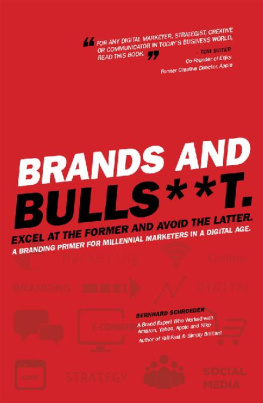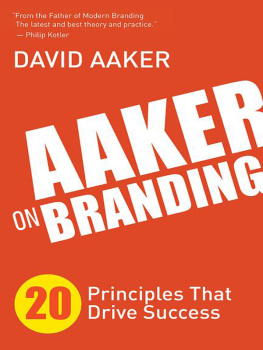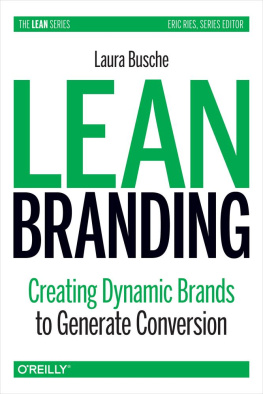Thank you for purchasing this How Design eBook.
Sign up for our newsletter and receive special offers, access to free content, and information on the latest new releases and must-have designing resources! Plus, receive a coupon code to use on your first purchase from MyDesignShop.com for signing up.
or visit us online to sign up at
http://howdesign.com/ebook-promo
Foreword
By Jay Ogilvy
Cofounder, Global Business Network
People have personalities. Brands have personalities. If you want to do good business by building a successful brand, you need to be skillful about matching your market with your brand. This book will help you to build and exercise that skill.
Both for brands and for people, we need good maps for charting their highways and byways. Until very recently, most of the maps weve been using have been less than adequate. Economists assume a rational man who maximizes utility with every purchase decision as if we each had to tap keys on our calculators before our next download from iTunes.
We know better.
Many of our purchase decisions are guided less by maximizing utility than by optimizing pleasure, or heightening intensity, or satisfying a sense of irony or We feel our ways into our purchases more than we think our ways there. But what maps do we have for our feelings? Where are the highways and byways?
Psychologists hold the charts. But psychology, like economics, has gone through some changes. Just as economists have had to supplement some of their old hyperrational charts with a new field of behavioral economics that gets closer to the ways real people think and feel, so psychologists have come to see that the charts handed down by Freud dont quite do the trick.
In Freuds ego psychology, the ego does its best to mediate between the irrational urges of the id and the moralistic constraints of the superego. Where id was, let ego be, said Freud. Master those impulses. Meet and tame those repressed urges. Well, maybe.
Or maybe you want to channel some of those urges and impulses along the highways and byways of playful games. Or work. Or the simple joys of companionship. Or love.
Life consists of more than getting and spending, or simple calculations toward those ends. Life is richer than that, and businesspeople who are sensitive to that richness will do a better job of satisfying their customers than the bean counters calculating marginal utilities.
Archetypal psychology builds on Freud, but it offers a much richer set of charts for the human psyche. Just as behavioral economics takes us closer to life as really lived, so archetypal psychology takes us deeper into the dynamics of our feelings as they are really felt not as instincts or as drives, but with the human texture of myths and stories. The archetypes are symbolized by personalities like you and me, not by abstract principles. We recognize the archetypes. They are familiar, part of the human family. They speak to us.
In this book, you will be familiarized with the archetypes. But more important, you will be assisted in using these archetypes to make sense of your brand, even as you use the very same archetypes to make sense of your customers.
Further, rather than being subjected to a boring monologue from which you are supposed to derive the knowledge necessary to calculate your brand message, you will be invited to play, to interact, to get involved in a conversation.
In a form that is consistent with its content, this kit or package does for the conventional book what a good archetypal psychologist will do for the clinical hour: make it less cerebral, more holistic; less asymmetrical - doctor over patient, author over reader - and more participatory.
Archetypes in Branding will invite you into a game whose moves involve the inner reaches of the soul. This package does not claim answers to lifes deepest mysteries. But it certainly provides good tools for plumbing those mysteries. Use these tools and they will provoke good questions; they will evoke vivid images; they will stimulate the kind of conversation that will match your market to your brand.
CHAPTER ONE
Setting the Stage
An old Sufi folktale tells of a renowned trickster who for years stymied a tenacious border inspector as he frequently crossed into Persia on his donkey. In spite of numerous searches, the trickster was never found to be carrying anything but straw. The fruitless inspections went on for years. When finally the inspector retired, his mind still ruminated on this trickster, who he believed had evaded him. One day the inspector spotted the trickster sitting idly in the marketplace. He approached him and pleaded, Wont you please tell me what youve been smuggling? Ill never rest in peace until I know. The trickster, being a kind man, did not wish the inspector to spend the rest of his days in torment and so replied, I was smuggling donkeys.
As creative strategists, we, the authors, sought the overlooked donkeys that could answer some of our most essential questions: What tools can we use to facilitate greater authenticity and meaning in our brand work? How can we encourage greater cultural uptake for a brand, both internally and externally? Whats the most basic and therefore universal way to align and integrate the myriad aspects of a brand? How do we move the conversation from the cognitive to the intuitive? It was from this place of questioning and exploring that we started applying the concepts of archetypes to the creative strategy work we do. Like the donkeys in the folktale, archetypes - the signs, symbols and themes of our lives - were right under our noses, hidden in plain sight.
Our exploration led to this important discovery:
In an age in which many people crave a deeper sense of connection to their work and want business to demonstrate greater integrity and accountability, the creative and mindful attention to archetypes can facilitate a more authentic, holistic and human way of being in business.
We are not Jungian experts but creative generalists with an appreciation of the rich store of useful information housed within the archetypal system. As witnesses and observers of society and culture, we seek multiple ways of understanding people and how they make choices. We subscribe to the practice of interdisciplinary cross-pollination. Our methods have shown the validity and applicability of Archetypes in Branding. Similar findings have been documented by advertising giant Young & Rubicam. Their research exploring the connection between economic performance and archetypes shows that brands associated with archetypal identities positively and profoundly influence the real asset valuation of their companies.
WHAT ARE ARCHETYPES AND HOW CAN THEY HELP?











